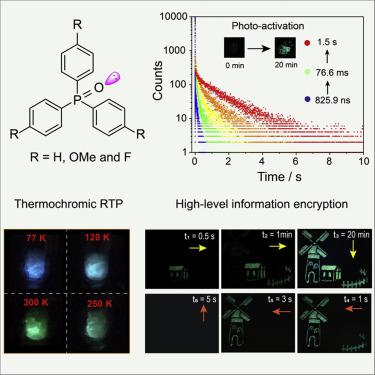Cell Reports Physical Science ( IF 7.9 ) Pub Date : 2021-07-21 , DOI: 10.1016/j.xcrp.2021.100505 Pengfei She 1 , Jinyu Lu 1 , Yanyan Qin 1 , Feiyang Li 1 , Juan Wei 1 , Yun Ma 1 , Weikang Wang 1 , Shujuan Liu 1 , Wei Huang 1, 2, 3 , Qiang Zhao 1, 2

|
Organic luminophores exhibiting reversible changes in persistent room-temperature phosphorescence (RTP) upon exposure to external stimuli have shown great potential in diverse advanced photonic areas. Here, we present a molecular design strategy for the rational control of photoactivated persistent RTP behaviors of a series of triphenylphosphine oxide derivatives. By introducing various substituent groups, the responsive behaviors, such as photoactivation speeds and emission decay times upon UV excitation, are finely controlled. Crystal analyses and simulated calculations reveal that variations in molecular stacking upon photoirradiation are responsible for different persistent RTP behaviors. Also, one of the luminophores exhibits tunable persistent RTP from blue to green upon changing temperatures. Eventually, information encryption and visual temperature detection of these molecules are successfully demonstrated. Our study will pave the way for further development of novel stimuli-responsive persistent RTP materials with controllable responsive behavior for advanced photonic applications.
中文翻译:

用于信息加密和视觉温度检测的可控光活化有机持久室温磷光
有机发光体在暴露于外部刺激时表现出持久室温磷光 (RTP) 的可逆变化,已在各种先进光子领域显示出巨大潜力。在这里,我们提出了一种合理控制一系列三苯基氧化膦衍生物的光活化持久 RTP 行为的分子设计策略。通过引入各种取代基,可以很好地控制响应行为,例如紫外线激发时的光活化速度和发射衰减时间。晶体分析和模拟计算表明,光照射时分子堆积的变化是造成不同持久 RTP 行为的原因。此外,其中一种发光体在温度变化时表现出从蓝色到绿色的可调持久 RTP。最终,成功证明了这些分子的信息加密和视觉温度检测。我们的研究将为进一步开发具有可控响应行为的新型刺激响应持久 RTP 材料铺平道路,以用于高级光子应用。











































 京公网安备 11010802027423号
京公网安备 11010802027423号